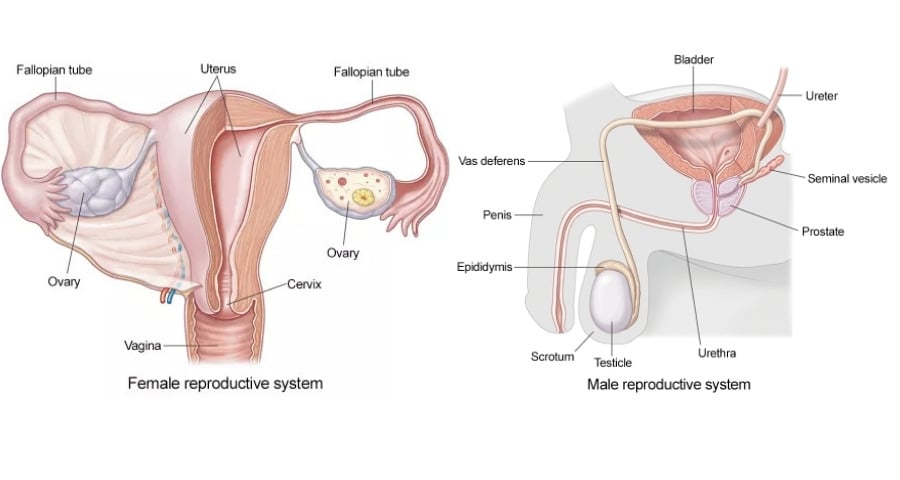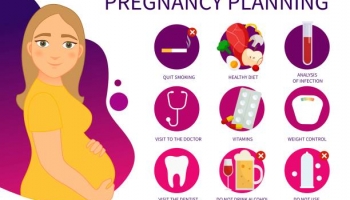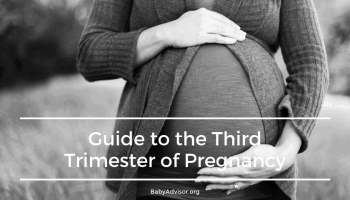
We all know the basics of how to make a baby. A man and woman need to have sex, and if the stars line up appropriately, then 40 weeks later, you have a beautiful new baby.
That sounds great, but there is a lot more to making a baby than what is on the outside. So many things are happening throughout the previous weeks leading up to conception. Biology is fascinating, and everyone should understand how conception truly takes place, from start to finish.
Chances are you have some questions. Are there differences between positions? Does orgasm help you conceive? There are many questions about how to make a baby, so let’s take a look at what you need to know.
What to Do Before You Try to Conceive
If you know that you’re going to try to conceive within the new few weeks or months, now is a great time to make an appointment with your doctor to discuss your overall health. You should also start taking a prenatal vitamin that contains folic acid, which is essential to reduce the risk of spinal tube defects.
Now is also the time to stop taking birth control. Ideally, you would stop your prescription a few months before you plan to start trying to conceive. That goes for other forms of hormonal birth control, as well. If you take Depo-Provera, that should be stopped around nine months before you want to conceive.
The Starting Points: Sperm and Eggs

Conception starts with two tiny little parts of our bodies – sperm and eggs.
For women, the potential pregnancy starts in the ovaries, which are two almond-shaped glands on either side of your uterus. Did you know that you were born with all of the eggs you would ever need? Ovaries come fully stocked at birth. Each woman has around one to two million eggs, which is more than you could ever need for a lifetime.
Eggs start to die off quickly, and your body will never produce more. You are born with your entire supply and can’t make more. Most women release around 400 eggs over your reproductive years, assuming you reach menopause between 45-55 years old.
What is Ovulation?
Eggs are a star player in conception. In the middle of your menstrual cycle, typically between the 9th and 21st days for a woman with 28 day long cycles, an egg reaches maturity in one of her two ovaries. Then, the egg is released and sucked into the nearest fallopian tube.
The release of the egg is called ovulation, and it starts your conception clock. Eggs typically live around 24 hours after ovulation, so fertilization needs to take place soon to conceive. If your egg meets healthy sperm during this 24 hours inside of your uterus, then they join, creating a new life.
If egg and sperm don’t meet, the journey ends in the uterus. The egg either dissolves or is absorbed into your body. When you don’t conceive, the ovary stops making estrogen and progesterone, which are two essential pregnancy hormones. The thickened lining of the uterus sheds during your period, which is why you bleed.
How Sperm is Made
A man’s body creates millions of microscopic sperm, all with the same goal – to fertilize an egg. Women are born with all the eggs that they need for their lifetime, but men aren’t made that way. Sperm is produced regularly, taking 64-72 days from start to finish to develop new sperm cells.
Sperm lives only a few weeks inside a man’s body. With each ejaculation, around 250 million sperm are released. As you might imagine, sperm is always in production. Sperm production starts in the testicles, which are the two glands in the scrotal sac beneath the penis.
Even though a man’s body releases millions of sperm with each ejaculation, only one sperm fertilizes the awaiting egg. That’s also the case for identical twins.
Once the sperm reaches the egg, the journey isn’t over. It has to penetrate the egg’s outer shell and get inside before the rest of them. The strongest one of the best makes it through, and the egg changes instantly to stop any other sperm from penetrating. You can imagine a shield clamping down over the egg.
How to Make a Baby - Determine When You’re Fertile
Most couples want to chart the woman’s cycle to determine optimal fertility. That increases the chances of catching the egg on the first or second try.
Your fertile window is five to six days long, typically in the middle of your cycle. An average woman has a 28-day cycle with ovulation on cycle day 14. However, not all women are the average woman, so everyone should chart their cycles to identify your unique fertile days.
The first thing that you need to do is chart your cycles. You can use an app or a printed chart. You also need to have a basal body thermometer (you can find these at Wal-Mart or Amazon). On your chart, you’ll mark when you have your menstrual cycle.
Each day, you’ll take your waking temperature at the same time each day. Then, chart the temperature using whatever method you selected. After you ovulate, your temperature will increase. Charting your basal body temperatures lets you know your average ovulation date, ensuring you pick the right days to have sex.
If you take your temperature each day, some women notice that they have a slight temperature drop just before they ovulate. If you see a drop, then an increase, you know you ovulated.
Typically called OPKs, these are little strips that look like pregnancy tests. All you have to do is pee on the strip or dip the strip in a cup of urine. OPKs measure your hormones to determine how close you are to ovulation. If the test line is as dark or darker than the control, the chances are high that you’re fertile.
The cervix is grossly misunderstood and underappreciated in our society. Not only is it the gateway that stands between you and your developing baby until childbirth, but what your cervix is doing is a significant indicator of fertility or infertility.
Cervical mucus is the normal vaginal discharge that you see each month. Throughout your cycle, your cervical mucus goes from nonexistent to dry or sticky, then changes to creamy and wet. Finally, it turns to a consistency of egg whites. When you see the egg white cervical mucus, that means you are at your peak fertile time, and you are close to ovulation.
Egg white cervical mucus is the most desired for conception because it’s the most sperm-friendly. It lets the sperm swim quickly up to the uterus, finding and fertilizing the egg.
Some women might feel a bit strange checking their cervical position, but it can be quite insightful. When you are close to ovulating, your cervix will be soft, high, and more open. It’s essential to check your cervical position daily while you are still learning your cycles and what is typical for you.
During this time, you might also experience pain or cramping, breast tenderness, spotting, and an increased sex drive.
Using an app can be very helpful! Apps let you track your period, add in ovulation signs and tests, track sexual intercourse, and your temperature. These apps help you to determine your most fertile days.
When is the Best Time for Conception Sex?

Once an egg is released from your ovary, it survives for 12-24 hours. So, sperm needs to meet egg within that window to successfully become fertilized. The good news is that healthy sperm lives up to five days inside of your body.
That feels crazy, right?
You can have sex, and the sperm still be alive inside of your fallopian tubes two to three (or longer) days later! So, the best time to have conception sex is when the sperm and egg are alive and inside your body at the same time.
Let’s look at an example.
If you ovulate on Wednesday evening, having sex anytime on Wednesday is a close guarantee that sperm will meet the egg during the 12 to 24-hour window. If you had sex on Monday or even Sunday, the sperm might still be alive and waiting for its date with the egg. Once you know when you ovulate, you can pick the optimal times to have sex to increase the chances of having living sperm ready for the egg.
How Often Should You Have Sex While Trying to Conceive?
If you don’t want to track your ovulation, the best course of action is to have sex every other day until your period arrives. That’s a lot of sex, but figuring out how to make a baby is hard work, right?
For those tracking ovulation, assuming that your partner has an average or high sperm count, you can have sex every day in your fertile window. For those with a low sperm count, aim to have sex every other day to help boost the sperm concentration.
Sperm is at its healthiest prime when men ejaculate every two to three days. So, that means your guy doesn’t want to wait too many days between orgasms.
Does Sex Position Matter for Conception?

You might wonder if certain sex positions are better for baby-making. Some friends might have told you that they have success with specific positions that allow for deeper penetration.
While it’s fun to give different sex positions a try, no evidence proves that any sex position increases your success rate of conceiving.
Does a Female Have to Orgasm to Conceive?
Orgasm is a wonderful part of sexual intercourse, but do you need to have an orgasm to conceive?
For men, the answer is yes. An orgasm sends the sperm-filled semen into the vagina, up into the cervix, reaching the fallopian tubes in just a few minutes. Orgasm gives sperm its head start towards the destination egg.
For women, the answer varies. Some evidence suggests that the wavelike uterine contractions caused by the female orgasm pull the sperm further into the cervix. However, there is no actual proof that this is true.
Having an orgasm is nice, and it might help your chances of getting pregnant, but it’s not essential.
Are Lubricants Safe for Conception?
Lubricants with spermicide are a no-go if you want to conceive. The spermicide will kill off any of the sperm that comes out.
Most regular lubricants, such as KY Jelly, are not sperm-friendly either. This is important for couples who have infertility issues because they might have fewer arousal fluids. Hormonal imbalances decrease cervical mucus.
Instead, purchasing fertility-friendly lubricants is a smart idea. Some of the most popular ideas include Pre-Seed, Conceive Plus, and Astroglide. Another choice is fragrance-free baby oil or coconut oil.
When to Take a Pregnancy Test

You timed sex the best that you can, so when should you take a pregnancy test to find out if your efforts worked?
In general, your menstrual cycle will start 14 days after ovulation. It should come around 28 days after your last menstrual period, give or take a few days.
The best time to take a pregnancy test is when your period is late. Wait until the 14 days arrive, and if your cycle doesn’t come, then take a pregnancy test.
It can be tough to wait that long! Pregnancy test companies understand that desire, so they’ve worked to create tests that can determine pregnancy up to six days before you miss a period. Now, the accuracy of the test is lower, depending on how early you take the test. Pregnancy tests are more accurate, the longer you wait and the closer to your expected cycle.
Read more useful guide: How can you take preparation for pregnancy?
Final Thoughts
Learning how to make a baby is a big deal. It’s normal for couples to need to try to conceive for a few months. You have to time it right to catch that one egg, so you only have one shot each month. Don’t fret if it doesn’t happen the first or second month. That’s totally normal! Making a baby is more than just sex; it takes science and timing.






